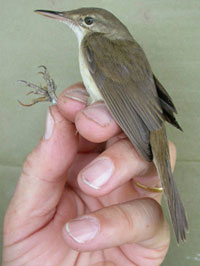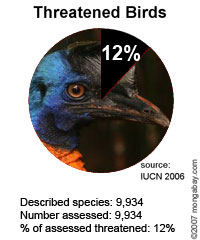Bird species rediscovered after 139 years
Bird species rediscovered after 139 years
mongabay.com
March 6, 2007
A wetland bird that has been “lost” for nearly 140 years was rediscovered at a wastewater treatment plant in Thailand according to bird conservation group BirdLife International.
The Large-billed Reed-warbler (Acrocephalus orinus) was spotted by ornithologist Philip Round, a biologist at Mahidol University in Bangkok. Previously the only known example of the species was collected in the Sutlej Valley of India in 1867.
Round says he knew he had found something special when he sighted the bird.
“Although reed-warblers are generally drab and look very similar, one of the birds I caught that morning struck me as very odd, something about it didn’t quite add up; it had a long beak and short wings,” said Round in a statement. “Then, it dawned on me—I was probably holding a Large-billed Reed-warbler. I was dumbstruck, it felt as if I was holding a living dodo.”
“I knew it was essential to get cast-iron proof of its identity. I took many photographs, and carefully collected two feathers for DNA analysis, so as not to harm the bird.”
 Large-billed Reed-warbler. Photo by Philip Round/The Wetland Trust
|
Analysis of the photos and feather by professor Staffan Bensch of Lund University in Sweden concluded that the bird was indeed the lost long species.
“This rediscovery of the Large-billed Reed-warbler on the shores of Inner Gulf of Thailand… illustrates the importance of wetland habitats and the remarkable biodiversity they are home to,” said Kritsana Kaewplang, director of the Bird Conservation Society of Thailand (BCST). “It also demonstrates the contribution of routine monitoring and ringing of migratory birds at even well-known sites.”
“Almost nothing is known about this mysterious bird. The Indian specimen has short, round wings and we speculated it is resident or short-distance migrant, so its appearance in Thailand is very surprising,” said Dr Stuart Butchart of BirdLife International. A priority now is to find out where the Large-billed Reed-warbler’s main population lives, whether it is threatened, and if so, how these threats can be addressed.”
“Now people are aware Large-billed Reed-warblers are out there, we can expect someone to discover the breeding grounds before long. Myanmar or Bangladesh are strong possibilities, but this species has proved so elusive that it could produce yet another surprise,” Butchart added.
This article uses quotes from a statement released by BirdLife International
